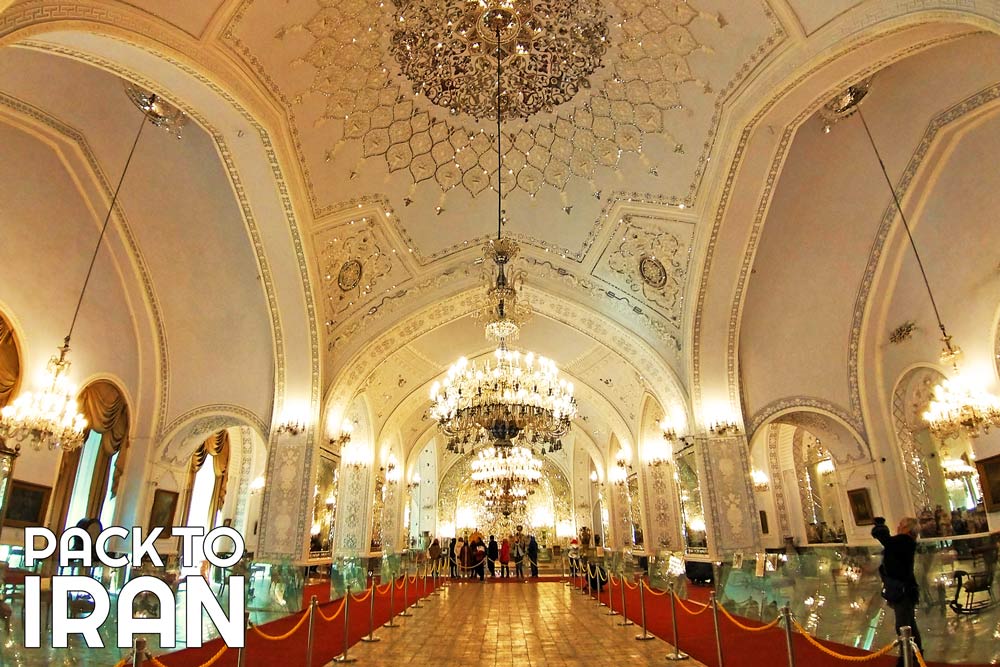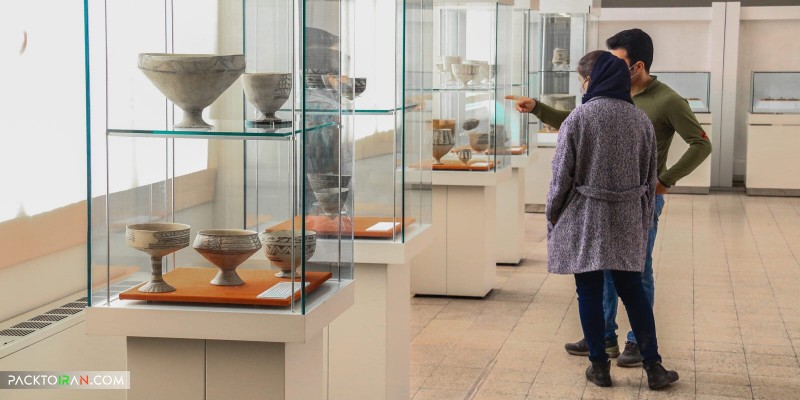Golestan palace - Tehran, Iran
Golestan palace is a historic royal complex located in the center of Tehran, the capital of Iran. The Golestan Palace is a must-visit destination for anyone traveling to Iran. This UNESCO World Heritage site boasts stunning architecture, intricate tilework, and beautiful gardens. Visitors can explore the palace's many halls and rooms, including the Mirror Hall and the Marble Throne Room. The palace also offers a glimpse into Iran's rich history and culture, with exhibits showcasing traditional art, clothing, and weaponry. For those interested in photography, the palace provides endless opportunities to capture breathtaking shots. Overall, a visit to this fully detailed Palace in Tehran is an unforgettable experience that should not be missed.. Today, Golestan palace is one of the most visited historic places on Tehran tours, attracting visitors from all over the world.
|
|
| Golestan Palace - Tehran, Iran |
History of Golestan palace of Tehran
During the kingdom of Safavids (16th – 18th century), a citadel was built at the location of Golestan palace of Tehran and that became the origin of later constructions and expansions. Karim Khan, the king of Zand dynasty (18th century) did some renovations but the main buildings and changes were made during the kingdom of Qajars in Iran (18th – 20th century). The Qajar family took control of Iran after defeating Zand dynasty. After Agha Mohammad Khan, the founder of Qajar dynasty, chose Tehran as his capital (1794), Golestan palace became the official residence for him and the further six kings. It was during the reign of the Naser al-Din Shah (1848 – 1896), the 4th king of Qajar that most of the buildings were built. He destroyed most of the palaces built by the former kings, and started new constructions. So, what we see today looks a lot like the time of Naser al-Din Shah Qajar. The initial area of the Golestan palace was about 450 hectars, and only 4.5 hectars remains. Naser Al-Din Shah was the first Persian king who travelled to Europe, so some of the buildings he made, were inspired by European architecture. During the kingdom of the two Pahlavi Kings (1925 – 1979), they built their own palaces north of Tehran and used the Golestan palace for reception ceremonies. Both Reza Shah and Mohammad Reza Shah held their coronation ceremonies in this Golestan. After the Islamic republic revolution in 1979, the management of the Golestan complex was given to the cultural heritage and tourism organization.
|
|
| Golestan Palace - Tehran, Iran |
Main Parts of the Golestan palace of Tehran
The complex of Golestan palace of Tehran consists of several palaces, museums, gardens, halls and galleries as listed below. The collection of the gardens, palaces and tile works have made the most unique historical and tourist attractions to visit in Iran. There is a garden in the middle of the complex with beautiful pools and ponds. What makes this section more beautiful is the exterior decoration of the palaces, mainly tile works with attractive colors. Golestan palace in Tehran is actually a stunning museum of tile works. Every part of the Golestan palace of is very attractive and full of details, and makes stunning frames for photography.
|
|
| Golestan Palace - Tehran, Iran |
The Salam Hall in Golestan palace of Tehran
Salam Hall or the greeting hall in the Golestan palace of Tehran was originally built by the order of Naser al-Din Shah to be used as a museum and became the first museum of Iran. He made this decision after he made his first travel to Europe. He ordered to collect and exhibit Persian and European paintings, gifts presented to him by other countries and also a valuable collection of jewels. Most of the jewels are now kept in the Royal Jewels Museum at the Central Bank of Iran, but most of the paintings and gift collections are still kept and exhibited in the Golestan palace. The “Sun throne” which was the royal throne of the Qajar kings and was used by kings in reception ceremonies and special celebrations like Nowruz (Persian new year), was kept in Salam hall till 1980. People and the court members were going to the king sitting on the Sun Throne to say Salam (Hello), that’s the reason this hall is called “Salam”. Both Pahlavi kings hold their coronation ceremonies in Salam hall and for that they changed the decoration of the hall. Today you can visit this hall and see a collection of the gifts presented to the Qajar kings from all over the world alongside painting from famous Iranian painters like Kamal-ol-molk. The Sun throne was moved to Royal Jewels Museum at the Central Bank of Iran where it is now available to display.
|
|
| Salam Hall - Golestan Palace - Tehran, Iran |
The Mirror Hall in Golestan palace of Tehran
The Golestan Palace of Tehran boasts the magnificent Mirror Hall, an extraordinary space located adjacent to the Salam Hall. Despite its relatively small size, this hall is a true gem adorned with thousands of intricately crafted pieces of mirror, showcasing the exquisite Iranian art form known as Mirror work. It is precisely this stunning display that has earned the hall its name. Notably, Kamal-ol-molk, a renowned Iranian painter from the late 19th and early 20th centuries, dedicated five years to completing a masterpiece within the Mirror Hall. This remarkable painting depicts none other than Naser al-Din Shah himself. Today, visitors can marvel at this significant work of art as it is proudly exhibited in the Salam Hall of the Golestan Palace.
|
|
| The Mirror Hall - Golestan Palace - Tehran, Iran |
The Ivory Hall in Golestan palace of Tehran
The Ivory hall or the Aaj Hall, is a big hall next to the Mirror hall, and its former usage was the main dining hall of the Golestan palace of Tehran. There are 2 big ivories kept in this hall which are believed to be gifts from India and the reason for the denomination of the hall. Today, big portrait paintings of Qajar kings are now exhibited on the walls of the Ivory hall. The Containers Hall Next to the Ivory hall, this big hall exhibits a magnificent collection of Chinaware arranged in showcases. This is a collection of the chinaware presented to Qajar kings as gifts, mainly from European countries like the ones dedicated by Napoleon Bonaparte or Queen Victoria.

Golestan Palace of Tehran - Iran
The Brilliant Hall in Golestan palace of Tehran
This amazing hall is named Brilliant, or the former Boloor Hall, in the Golestan palace of Tehran because of its magnificent mirror work decoration done by Iranian artists. This hall was used for special dining ceremonies. In 1856, Alexander I, Tsar of Russia, presented a crystal basin to Fath-Ali-Shah, which was installed in one of the royal buildings. In 1920, part of the roof of the Narenjestan mansion collapsed, and this caused Naser al-Din Shah thinking about making changes in the internal buildings. After this time, changes were made in Brilliant mansion or the Brilliant Hall. For the first time in 1924, Naser al-Din Shah, announced the construction of Brilliant Hall. After these changes, the Brilliant mansion was being divided into rooms, which from east to west were named as: the waiter's room, the brilliant hall, the Bloor or Salam hall, and the dining room. This room later became known as the pantry or drink house, during the Pahlavi period. This hall is currently used as a museum and its mirrors and chandeliers are really eye-catching.

Kamal-Ol-Molk Painting of the Golestan Palace of Tehran
The Windcatchers Palace in Golestan palace of Tehran
Windcatcher or as called in Farsi “Badgir” is a genius architectural element in Iran and in Golestan palace of Tehran, which is used as a ventilation and cooling system for hot days of the year. The old city of Yazd would be the best place to see these windcatchers in Iran. Why this palace is called Windcatchers palace? Simply because this beautiful building contains of 4 windcatchers decorated with colorful mosaic tiles. To boost the ventilation, a small pool is built in the underground section of the palace. This building was mainly used during the hot days of summer as a chilling and relaxing place for the Qajar kings. The decoration of this palace is among the most beautiful ones in the complex.
|
|
| The Windcatcher - Golestan Palace - Tehran, Iran |
Edifice of the Sun or Shams ol Emareh, in Golestan palace of Tehran
Shams ol Emareh is one of the most delightful buildings in the Golestan palace of Tehran. Naser al-Din Shah ordered the construction of the building after he saw some photos of the tall buildings in Europe, although the architect was inspired a lot by the Safavid Aali Qapu palace in Esfahan. When the building was finished, it became the tallest building in Iran for many years. The king liked to stand in the balcony and watch the Golestan palace in Iran, and the soldiers marching and his under command capital, Tehran. After the construction was finished, Queen Victoria sent a clock as a gift for the Persian king. It was located on the building and people of the capital could hear the bell rings from far away. After a while the royal family started complaining about the noisy clock. After the attempts to make the clock less noisy, it stopped working, but they did not remove it from the building.
|
|
| Shams ol Emareh - Golestan Palace - Tehran, Iran |
The Museum of Gifts in Golestan palace of Tehran
The museum of gifts or the special museum is located in the northern part of Golestan palace of Tehran and on the lower floor of Salam Hall. The entrance of this museum is from the gallery. You can see the eye-catching white and light blue stucco works, on the door, walls and arches. This museum is the first museum in Iran that was built by Ibrahim Khan Memarbashi. During the Qajar period, many gifts, including silver and porcelain dishes from European countries were presented to the Qajar kings, and were kept in this area. In the center of all the collections and in a glass box, something that is very noticeable is kept. It is the crown of Agha Mohammad Khan Qajar with enamel decorations. The main material of the crown is copper.
|
|
| Salam Hall - Golestan Palace - Tehran, Iran |
The Abyaz Hall ( the white hall), in Golestan palace of Tehran
The Abyaz Hall, also known as the White Hall, is a prominent feature of the Golestan Palace in Tehran. Its name derives from the main white color of the building, which was inspired by European architecture. The decision to construct this section of the palace was primarily driven by Naser al-Din Shah's collection of numerous gifts, particularly those received from Ottoman Sultan "Abdul Hamid". Over time, this exquisite structure has transformed into the Museum of Anthropology in Tehran. As visitors explore its halls and corridors, they are captivated by the rich history and cultural significance showcased within its walls. From ancient artifacts to traditional costumes and crafts, this museum offers a fascinating glimpse into Iran's diverse heritage.

A Statue of Naser Al-Din Shah in the Golestan Palace - Iran
The Marble Throne Terrace, in Golestan palace of Tehran
The Marble Throne Terrace, located within the magnificent Golestan Palace of Tehran, is a true masterpiece that showcases the grandeur and opulence of Persian architecture. This historical site, a must-visit for tourists and locals alike, offers a glimpse into Iran's rich cultural heritage. The Marble Throne Terrace is an architectural marvel adorned with intricate carvings and exquisite tile work. Its centerpiece, the marble throne, is a symbol of power and authority. Visitors can marvel at the intricate details of the throne and imagine the rulers who once sat upon it. The Marble Throne Terrace stands as one of its most iconic attractions, attracting visitors from around the world who seek to immerse themselves in Iran's history and architectural brilliance. This terrace is among the oldest sections of the Golestan palace complex, decorated by paintings, marble carvings, tiles, mirrors and enamel. The famous marble throne is in this terrace. This throne was built by the order of Fath Ali Shah, the second king of Qajars, to be used for coronation and reception ceremonies. It's built by Iranian artists using the charming yellow marble from Yazd. The throne was last used for the coronation of Reza Shah (1926).

Iranian Girl in Front of A colorful Tilework in Golestan Palace of Tehran - Iran
The Karim Khani Nook, in Golestan palace of Tehran
This terrace is smaller in comparison to the Marble Throne terrace and is believed to be the oldest section of the Golestan palace of Tehran complex built and used by the order of Karim Khan, the founder of Zand dynasty (1750 – 1779). After Agha Mohammad Khan founded the Qajar dynasty, he ordered to bring out the body of the Karim Khan, the former king who was buried in Shiraz, to be buried again this time under the staircase of this terrace so that the new king would walk over him. There is another marble throne on this terrace, yet smaller than the one in the Marble throne terrace. Also, the beautiful tomb stone of Naser al-Din shah is placed on this terrace. This marble tomb stone took 5 years to be made.
|
|
|
The Karim Khani Nook - Golestan palace - Tehran, Iran
|
Tips for visiting the Golestan palace of Tehran
- The Golestan palace complex is open for visit at 9.00. You can buy the entrance ticket for each section separately, so make your decision before entering the complex. It takes at least 2 hours to make an average visit. There is a restaurant, a café, gift shops and bookstores inside the complex too. Visiting all of the museums and halls take at least 6 hours, so our suggestion for you is to buy all the tickets. It does really worth spending time.
- Buying the entrance ticket is mandatory. With this ticket you can visit the garden, the Karim Khan Nook, the marble throne terrace, the gift shops, restaurants and the palaces from outside. Make sure to visit the exterior tile work decoration of the palaces, it is an endless world of colorful tiles.
- The main hall (including 1. The Salam hall 2. The museum of gifts 3. The painting hall 4. The mirror hall 5. The Ivory hall 6. The containers hall 7. The Brilliant Hall. So, make sure to get this ticket. It takes around 1 hour to visit all.
- The wind catcher's hall. This is a small yet very beautiful palace in the complex. It takes about 10 minutes to visit.
Watch a video tour of Golestan Palace:
https://www.youtube.com/watch?v=4qe4to3RW-g
Interested in visiting the unique Golestan palace of TehranInterested? Here check out and book our upcoming Tehran City Tour:
Interested in taking a tour for visiting the museums of Tehran? Here check out and book our upcoming Tehran Museums Tour:
















